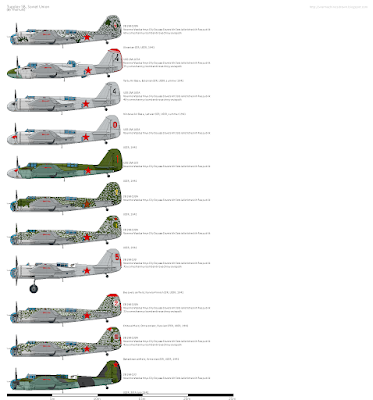A blog dedicated to draw historical, ahistorical and fictional warplanes and other military vehicles in 1/34 scale. Disclaimer: We just draw for the fun of doing it. If you want you can display the drawings of this blog in your website or forum as long as you credit the source. To properly view the drawings, click on them.
Wednesday 24 January 2024
Tupolev SB in Soviet Service. Part Eight.
Wednesday 17 January 2024
Tupolev SB in Soviet Service. Part Seven.
Thursday 28 December 2023
Tupolev SB in Soviet Service. Part Three.
The Tupolev SB was Soviet's main bomber during the Winter War. During this conflict, ranging from late November 1939 until until mid March 1940, the VVS deployed more than 3.000 aircraft to defeat the Finns who had only 145 aircraft in their ranks.
As we said, the Tupolev SB was VVS' main bomber and it flew the first Soviet attack against Finnish soil, which was an attack against Helsinki, the Finnish capital city. As the winter was really harsh, many Tupolev SB 2M-100As were equipped with skis and some few of them were equipped with the, back then, experimental MV-3 rear turret. The RS-132 unguided rocket was also tested in this conflict as six Tupolev SB 2M-100As were fitted with rocket launching equipment on the wings. These rockets were mainly used against ground targets.
As the war progressed on, with a furious Finnish resistance, many Tupolev SB of various types were captured by the Finnish who repaired them and push them into service with the Ilmavoimat (Finnish Air Force).
The war ended on 13th March 1940 with the Finnish agreeing to yield a buffer zone to the Soviets. However, casualties on the VVS side were enormous, estimated at a number between 700 and 900 aircraft, half of them bombers.
The Tupolev USB was the trainer variant of the regular SB which came out almost two years after the first SB rolled out of the factory in 1936. It was based on a SB 2M-100A and was built at GAZ (State Aircraft Factory) 22 at Fili, Moscow. The whole nose section was remodelled to install a second open cockpit for the instructor. The step was relocated from the front to the rear of the starboard nose. A windshield was installed for the instructor's compartment but no canopy was provided. Instructor's cockpit had similar controls to those in the pupil's cockpit, however, they were automatically disconnected when the instructor took command. In spite of the importance of communication between the instructor and the pupil, the USB lacked an intercom. The instructor accessed his cockpit using a ladder placed through the open ventral hatch doors.
The USB prototype underwent State Acceptance Trials between 11 and 16 March 1938. During those tests it was equipped with non-retractable ski undercarriage. GAZ 22 at Fili completed just a few USB, as most of them were converted in the field from existing Tupolev SB of every kind.
3rd https://en.wikipedia.org/wiki/Winter_War
Thursday 22 June 2023
Tupolev SB in Finnish service. Part two.
Tuesday 6 June 2023
Tupolev SB & Avia B-71 in service with Poland and Slovakia.
- Poland: During World War 2 some Polish pilots in the USSR were trained with the Tupolev USB (the dual-control trainer variant). These pilots belonged to the 9th Group stationed at Buguruslan, in Chkalov oblast (nowadays Orenburg oblast). Just after the war, five USB trainers were delivered to the Aviation Officers School at Deblin, in the Lublin Voivodeship, to serve as trainers. In 1947 they were re-engined with M-105 engines. This change required a redesign of the exhaust collector system, while different propellers with more ogival spinners were also installed. Three of the five USB served with the Wojska Lotnicze (Polish Air Force) at the Aviation Officers School until August 1949. This marked the longest use of the Tupolev USB outside the USSR, than any other country.
- Slovakia: When Germany invaded Czechoslovakia in March 1939, the state was split into the Protectorate of Bohemia and Moravia and the independent Slovak Republic. The Slovenské vzdusné zbrane ( SVZ - Slovak Air Force) had a total of 300 aircraft, among them three Avia B-71.
Just before the annexation, one B-71 had to perform a forced landing in the Slovakian part of Czechoslovakia, where it remained well after the split. Hungarian troops occupied the Carpatho-Ukraine region (Ruthenia) and looked to expand their borders in southern Slovakia. This soon led to various clashes which eventually escalated into the Slovak-Hungarian War of late March 1939 in the context of which, on 24th March ten Magyar Királyi Honvéd Legiero (MKHL - Royal Hungarian Air Force) Junkers Ju.86K-2 bombers attacked the airfield of Spisská Nová Ves, in the Kosicé region. This raid damaged one B-71 stationed there.
The B-71 that force landed in Slovakia before the German occupation, was repaired during the spring of 1939 and received SVZ codes and the blue V3 registration. It was also fitted with German radio equipment, a direction finding loop antenna and an antenna mast mounted on the upper fuselage behind the cockpit. Two additional rack antennas were also fitted to the lower rear fuselage with the original retractable antenna being retained. Both balance weights were also removed from the lower right wing.
On 18th April 1943 five Slovak airmen scaped to neutral Turkey in the blue V3 B-71. Sergeant Anton Vanko took off from Trencianske Biskupice airbase, close to the town of Trencin, in western Slovakia. Aboard the B-71 were Privates First Class J.Koman, J. Bzoch, L.Slezak and L.Pollak. The B-71 flew from Trencianske Biskupice to Kestanelik, in the Çanakkale province of Turkey, where they were interned for a brief period of time. The five Slovak airmen then travelled to England via North Africa, where they joined the various Czechoslovak Royal Air Force's (RAF) squadrons. Vanko became a Supermarine Spitfire pilot at the No. 312 (Czechoslovak) Squadron at RAF Bradwell Bay, in Essex. Unfortunately he was killed in a take off accident on 8th December 1944.
3rd https://massimotessitori.altervista.org/sovietwarplanes/pages/sb/tapani/b-71/czech%2Bslovak/czech%2Bslovak.htm









